Assignment on Lab Report - 1
VerifiedAdded on 2022/09/26
|7
|1422
|19
Assignment
AI Summary
Contribute Materials
Your contribution can guide someone’s learning journey. Share your
documents today.

LAB REPORT 1
LAB REPORT
Course name
Professor’s name
University name
City, State
Date of Submission
LAB REPORT
Course name
Professor’s name
University name
City, State
Date of Submission
Secure Best Marks with AI Grader
Need help grading? Try our AI Grader for instant feedback on your assignments.
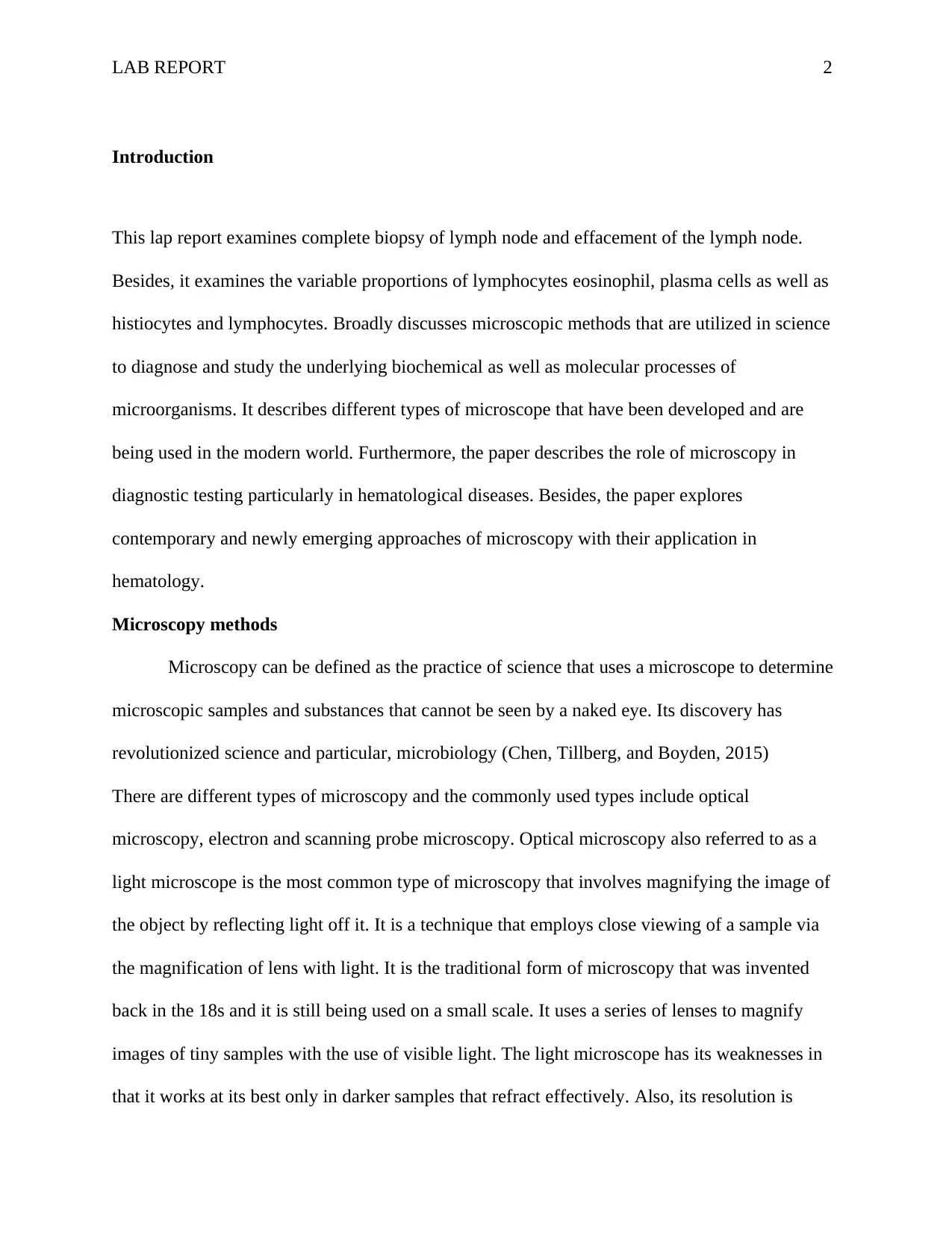
LAB REPORT 2
Introduction
This lap report examines complete biopsy of lymph node and effacement of the lymph node.
Besides, it examines the variable proportions of lymphocytes eosinophil, plasma cells as well as
histiocytes and lymphocytes. Broadly discusses microscopic methods that are utilized in science
to diagnose and study the underlying biochemical as well as molecular processes of
microorganisms. It describes different types of microscope that have been developed and are
being used in the modern world. Furthermore, the paper describes the role of microscopy in
diagnostic testing particularly in hematological diseases. Besides, the paper explores
contemporary and newly emerging approaches of microscopy with their application in
hematology.
Microscopy methods
Microscopy can be defined as the practice of science that uses a microscope to determine
microscopic samples and substances that cannot be seen by a naked eye. Its discovery has
revolutionized science and particular, microbiology (Chen, Tillberg, and Boyden, 2015)
There are different types of microscopy and the commonly used types include optical
microscopy, electron and scanning probe microscopy. Optical microscopy also referred to as a
light microscope is the most common type of microscopy that involves magnifying the image of
the object by reflecting light off it. It is a technique that employs close viewing of a sample via
the magnification of lens with light. It is the traditional form of microscopy that was invented
back in the 18s and it is still being used on a small scale. It uses a series of lenses to magnify
images of tiny samples with the use of visible light. The light microscope has its weaknesses in
that it works at its best only in darker samples that refract effectively. Also, its resolution is
Introduction
This lap report examines complete biopsy of lymph node and effacement of the lymph node.
Besides, it examines the variable proportions of lymphocytes eosinophil, plasma cells as well as
histiocytes and lymphocytes. Broadly discusses microscopic methods that are utilized in science
to diagnose and study the underlying biochemical as well as molecular processes of
microorganisms. It describes different types of microscope that have been developed and are
being used in the modern world. Furthermore, the paper describes the role of microscopy in
diagnostic testing particularly in hematological diseases. Besides, the paper explores
contemporary and newly emerging approaches of microscopy with their application in
hematology.
Microscopy methods
Microscopy can be defined as the practice of science that uses a microscope to determine
microscopic samples and substances that cannot be seen by a naked eye. Its discovery has
revolutionized science and particular, microbiology (Chen, Tillberg, and Boyden, 2015)
There are different types of microscopy and the commonly used types include optical
microscopy, electron and scanning probe microscopy. Optical microscopy also referred to as a
light microscope is the most common type of microscopy that involves magnifying the image of
the object by reflecting light off it. It is a technique that employs close viewing of a sample via
the magnification of lens with light. It is the traditional form of microscopy that was invented
back in the 18s and it is still being used on a small scale. It uses a series of lenses to magnify
images of tiny samples with the use of visible light. The light microscope has its weaknesses in
that it works at its best only in darker samples that refract effectively. Also, its resolution is
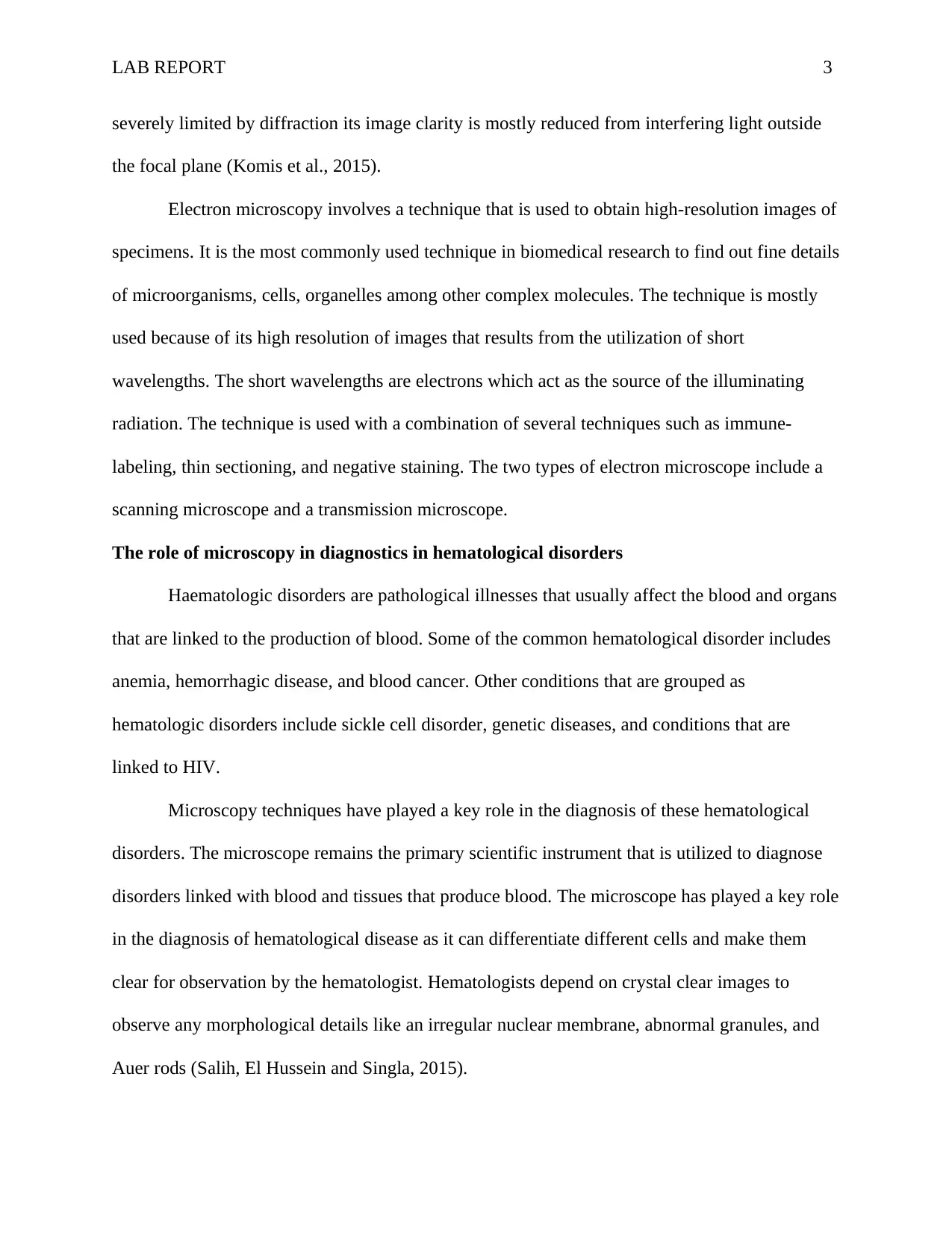
LAB REPORT 3
severely limited by diffraction its image clarity is mostly reduced from interfering light outside
the focal plane (Komis et al., 2015).
Electron microscopy involves a technique that is used to obtain high-resolution images of
specimens. It is the most commonly used technique in biomedical research to find out fine details
of microorganisms, cells, organelles among other complex molecules. The technique is mostly
used because of its high resolution of images that results from the utilization of short
wavelengths. The short wavelengths are electrons which act as the source of the illuminating
radiation. The technique is used with a combination of several techniques such as immune-
labeling, thin sectioning, and negative staining. The two types of electron microscope include a
scanning microscope and a transmission microscope.
The role of microscopy in diagnostics in hematological disorders
Haematologic disorders are pathological illnesses that usually affect the blood and organs
that are linked to the production of blood. Some of the common hematological disorder includes
anemia, hemorrhagic disease, and blood cancer. Other conditions that are grouped as
hematologic disorders include sickle cell disorder, genetic diseases, and conditions that are
linked to HIV.
Microscopy techniques have played a key role in the diagnosis of these hematological
disorders. The microscope remains the primary scientific instrument that is utilized to diagnose
disorders linked with blood and tissues that produce blood. The microscope has played a key role
in the diagnosis of hematological disease as it can differentiate different cells and make them
clear for observation by the hematologist. Hematologists depend on crystal clear images to
observe any morphological details like an irregular nuclear membrane, abnormal granules, and
Auer rods (Salih, El Hussein and Singla, 2015).
severely limited by diffraction its image clarity is mostly reduced from interfering light outside
the focal plane (Komis et al., 2015).
Electron microscopy involves a technique that is used to obtain high-resolution images of
specimens. It is the most commonly used technique in biomedical research to find out fine details
of microorganisms, cells, organelles among other complex molecules. The technique is mostly
used because of its high resolution of images that results from the utilization of short
wavelengths. The short wavelengths are electrons which act as the source of the illuminating
radiation. The technique is used with a combination of several techniques such as immune-
labeling, thin sectioning, and negative staining. The two types of electron microscope include a
scanning microscope and a transmission microscope.
The role of microscopy in diagnostics in hematological disorders
Haematologic disorders are pathological illnesses that usually affect the blood and organs
that are linked to the production of blood. Some of the common hematological disorder includes
anemia, hemorrhagic disease, and blood cancer. Other conditions that are grouped as
hematologic disorders include sickle cell disorder, genetic diseases, and conditions that are
linked to HIV.
Microscopy techniques have played a key role in the diagnosis of these hematological
disorders. The microscope remains the primary scientific instrument that is utilized to diagnose
disorders linked with blood and tissues that produce blood. The microscope has played a key role
in the diagnosis of hematological disease as it can differentiate different cells and make them
clear for observation by the hematologist. Hematologists depend on crystal clear images to
observe any morphological details like an irregular nuclear membrane, abnormal granules, and
Auer rods (Salih, El Hussein and Singla, 2015).
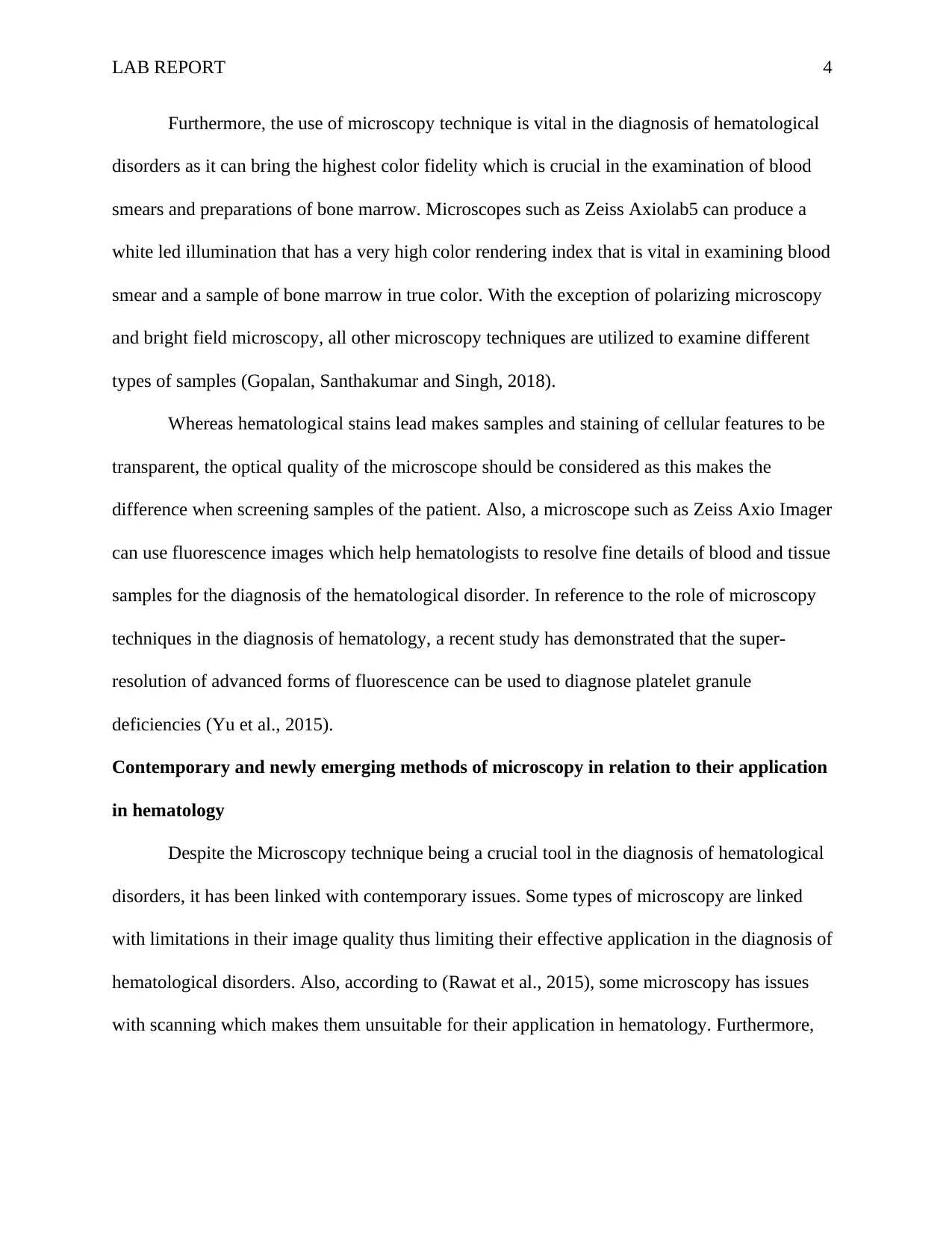
LAB REPORT 4
Furthermore, the use of microscopy technique is vital in the diagnosis of hematological
disorders as it can bring the highest color fidelity which is crucial in the examination of blood
smears and preparations of bone marrow. Microscopes such as Zeiss Axiolab5 can produce a
white led illumination that has a very high color rendering index that is vital in examining blood
smear and a sample of bone marrow in true color. With the exception of polarizing microscopy
and bright field microscopy, all other microscopy techniques are utilized to examine different
types of samples (Gopalan, Santhakumar and Singh, 2018).
Whereas hematological stains lead makes samples and staining of cellular features to be
transparent, the optical quality of the microscope should be considered as this makes the
difference when screening samples of the patient. Also, a microscope such as Zeiss Axio Imager
can use fluorescence images which help hematologists to resolve fine details of blood and tissue
samples for the diagnosis of the hematological disorder. In reference to the role of microscopy
techniques in the diagnosis of hematology, a recent study has demonstrated that the super-
resolution of advanced forms of fluorescence can be used to diagnose platelet granule
deficiencies (Yu et al., 2015).
Contemporary and newly emerging methods of microscopy in relation to their application
in hematology
Despite the Microscopy technique being a crucial tool in the diagnosis of hematological
disorders, it has been linked with contemporary issues. Some types of microscopy are linked
with limitations in their image quality thus limiting their effective application in the diagnosis of
hematological disorders. Also, according to (Rawat et al., 2015), some microscopy has issues
with scanning which makes them unsuitable for their application in hematology. Furthermore,
Furthermore, the use of microscopy technique is vital in the diagnosis of hematological
disorders as it can bring the highest color fidelity which is crucial in the examination of blood
smears and preparations of bone marrow. Microscopes such as Zeiss Axiolab5 can produce a
white led illumination that has a very high color rendering index that is vital in examining blood
smear and a sample of bone marrow in true color. With the exception of polarizing microscopy
and bright field microscopy, all other microscopy techniques are utilized to examine different
types of samples (Gopalan, Santhakumar and Singh, 2018).
Whereas hematological stains lead makes samples and staining of cellular features to be
transparent, the optical quality of the microscope should be considered as this makes the
difference when screening samples of the patient. Also, a microscope such as Zeiss Axio Imager
can use fluorescence images which help hematologists to resolve fine details of blood and tissue
samples for the diagnosis of the hematological disorder. In reference to the role of microscopy
techniques in the diagnosis of hematology, a recent study has demonstrated that the super-
resolution of advanced forms of fluorescence can be used to diagnose platelet granule
deficiencies (Yu et al., 2015).
Contemporary and newly emerging methods of microscopy in relation to their application
in hematology
Despite the Microscopy technique being a crucial tool in the diagnosis of hematological
disorders, it has been linked with contemporary issues. Some types of microscopy are linked
with limitations in their image quality thus limiting their effective application in the diagnosis of
hematological disorders. Also, according to (Rawat et al., 2015), some microscopy has issues
with scanning which makes them unsuitable for their application in hematology. Furthermore,
Secure Best Marks with AI Grader
Need help grading? Try our AI Grader for instant feedback on your assignments.
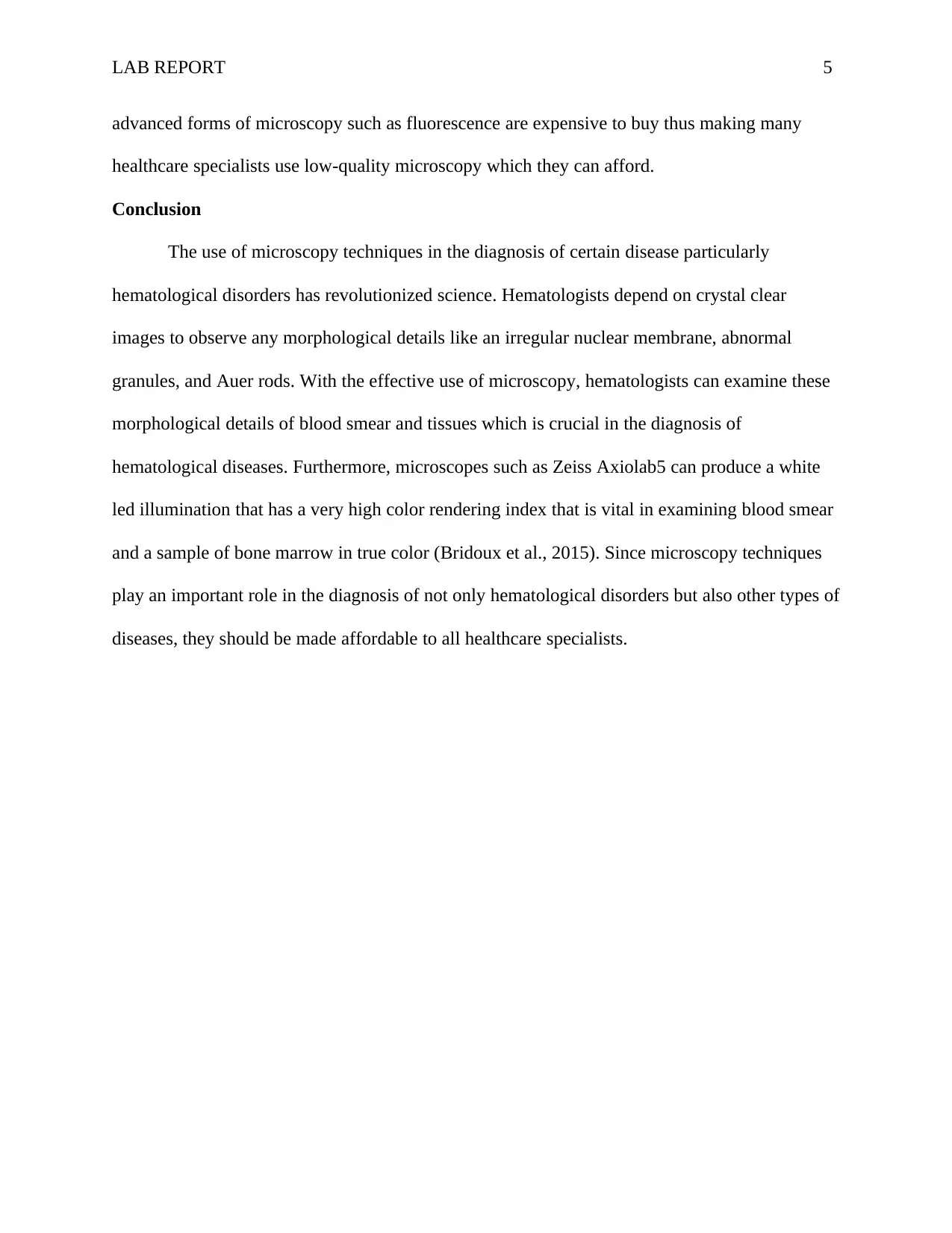
LAB REPORT 5
advanced forms of microscopy such as fluorescence are expensive to buy thus making many
healthcare specialists use low-quality microscopy which they can afford.
Conclusion
The use of microscopy techniques in the diagnosis of certain disease particularly
hematological disorders has revolutionized science. Hematologists depend on crystal clear
images to observe any morphological details like an irregular nuclear membrane, abnormal
granules, and Auer rods. With the effective use of microscopy, hematologists can examine these
morphological details of blood smear and tissues which is crucial in the diagnosis of
hematological diseases. Furthermore, microscopes such as Zeiss Axiolab5 can produce a white
led illumination that has a very high color rendering index that is vital in examining blood smear
and a sample of bone marrow in true color (Bridoux et al., 2015). Since microscopy techniques
play an important role in the diagnosis of not only hematological disorders but also other types of
diseases, they should be made affordable to all healthcare specialists.
advanced forms of microscopy such as fluorescence are expensive to buy thus making many
healthcare specialists use low-quality microscopy which they can afford.
Conclusion
The use of microscopy techniques in the diagnosis of certain disease particularly
hematological disorders has revolutionized science. Hematologists depend on crystal clear
images to observe any morphological details like an irregular nuclear membrane, abnormal
granules, and Auer rods. With the effective use of microscopy, hematologists can examine these
morphological details of blood smear and tissues which is crucial in the diagnosis of
hematological diseases. Furthermore, microscopes such as Zeiss Axiolab5 can produce a white
led illumination that has a very high color rendering index that is vital in examining blood smear
and a sample of bone marrow in true color (Bridoux et al., 2015). Since microscopy techniques
play an important role in the diagnosis of not only hematological disorders but also other types of
diseases, they should be made affordable to all healthcare specialists.
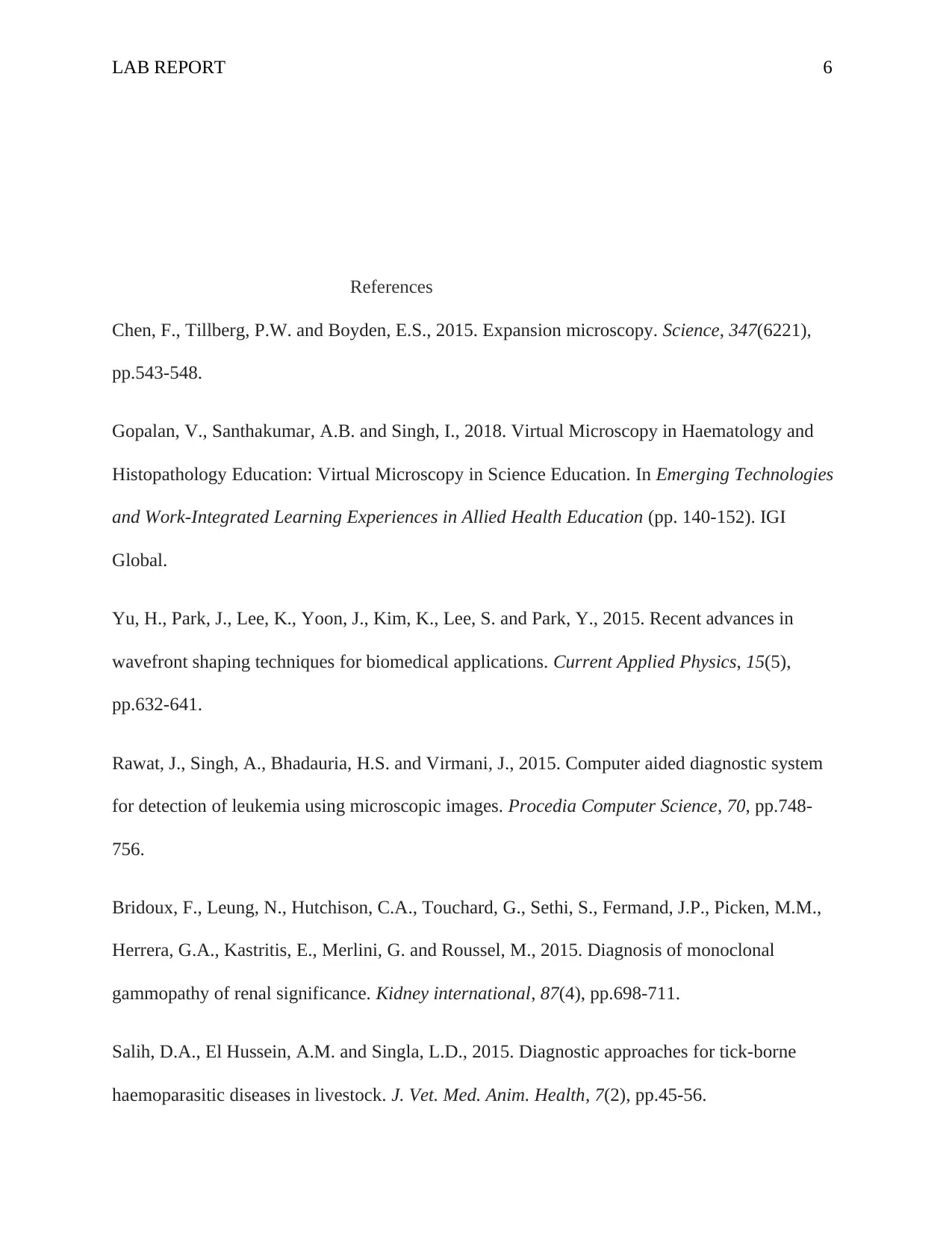
LAB REPORT 6
References
Chen, F., Tillberg, P.W. and Boyden, E.S., 2015. Expansion microscopy. Science, 347(6221),
pp.543-548.
Gopalan, V., Santhakumar, A.B. and Singh, I., 2018. Virtual Microscopy in Haematology and
Histopathology Education: Virtual Microscopy in Science Education. In Emerging Technologies
and Work-Integrated Learning Experiences in Allied Health Education (pp. 140-152). IGI
Global.
Yu, H., Park, J., Lee, K., Yoon, J., Kim, K., Lee, S. and Park, Y., 2015. Recent advances in
wavefront shaping techniques for biomedical applications. Current Applied Physics, 15(5),
pp.632-641.
Rawat, J., Singh, A., Bhadauria, H.S. and Virmani, J., 2015. Computer aided diagnostic system
for detection of leukemia using microscopic images. Procedia Computer Science, 70, pp.748-
756.
Bridoux, F., Leung, N., Hutchison, C.A., Touchard, G., Sethi, S., Fermand, J.P., Picken, M.M.,
Herrera, G.A., Kastritis, E., Merlini, G. and Roussel, M., 2015. Diagnosis of monoclonal
gammopathy of renal significance. Kidney international, 87(4), pp.698-711.
Salih, D.A., El Hussein, A.M. and Singla, L.D., 2015. Diagnostic approaches for tick-borne
haemoparasitic diseases in livestock. J. Vet. Med. Anim. Health, 7(2), pp.45-56.
References
Chen, F., Tillberg, P.W. and Boyden, E.S., 2015. Expansion microscopy. Science, 347(6221),
pp.543-548.
Gopalan, V., Santhakumar, A.B. and Singh, I., 2018. Virtual Microscopy in Haematology and
Histopathology Education: Virtual Microscopy in Science Education. In Emerging Technologies
and Work-Integrated Learning Experiences in Allied Health Education (pp. 140-152). IGI
Global.
Yu, H., Park, J., Lee, K., Yoon, J., Kim, K., Lee, S. and Park, Y., 2015. Recent advances in
wavefront shaping techniques for biomedical applications. Current Applied Physics, 15(5),
pp.632-641.
Rawat, J., Singh, A., Bhadauria, H.S. and Virmani, J., 2015. Computer aided diagnostic system
for detection of leukemia using microscopic images. Procedia Computer Science, 70, pp.748-
756.
Bridoux, F., Leung, N., Hutchison, C.A., Touchard, G., Sethi, S., Fermand, J.P., Picken, M.M.,
Herrera, G.A., Kastritis, E., Merlini, G. and Roussel, M., 2015. Diagnosis of monoclonal
gammopathy of renal significance. Kidney international, 87(4), pp.698-711.
Salih, D.A., El Hussein, A.M. and Singla, L.D., 2015. Diagnostic approaches for tick-borne
haemoparasitic diseases in livestock. J. Vet. Med. Anim. Health, 7(2), pp.45-56.

LAB REPORT 7
Komis, G., Šamajová, O., Ovečka, M. and Šamaj, J., 2015. Super-resolution microscopy in plant
cell imaging. Trends in plant science, 20(12), pp.834-843.
Komis, G., Šamajová, O., Ovečka, M. and Šamaj, J., 2015. Super-resolution microscopy in plant
cell imaging. Trends in plant science, 20(12), pp.834-843.
1 out of 7
Related Documents
Your All-in-One AI-Powered Toolkit for Academic Success.
+13062052269
info@desklib.com
Available 24*7 on WhatsApp / Email
![[object Object]](/_next/static/media/star-bottom.7253800d.svg)
Unlock your academic potential
© 2024 | Zucol Services PVT LTD | All rights reserved.





